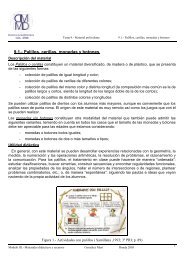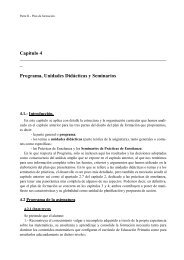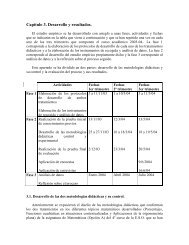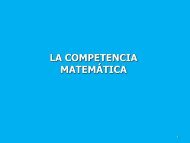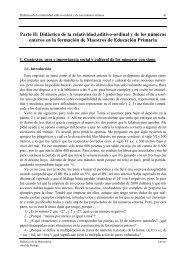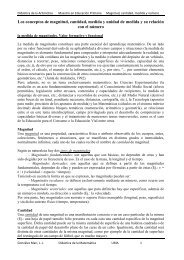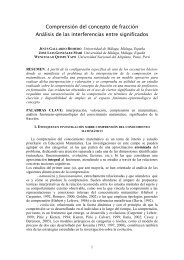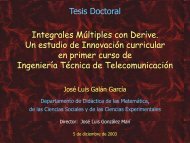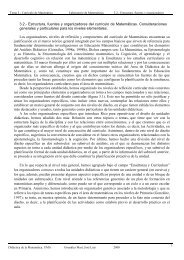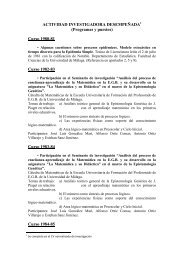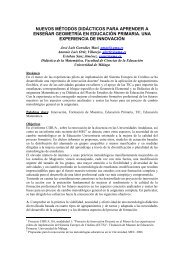LEVELS OF MODELLING COMPETENCE
LEVELS OF MODELLING COMPETENCE
LEVELS OF MODELLING COMPETENCE
Create successful ePaper yourself
Turn your PDF publications into a flip-book with our unique Google optimized e-Paper software.
<strong>LEVELS</strong> <strong>OF</strong> <strong>MODELLING</strong> <strong>COMPETENCE</strong><br />
Herbert Henning<br />
Department of Mathematics<br />
Otto-von-Guericke Universität Magdeburg, Germany<br />
Mike Keune<br />
Ökumenisches Domgymnasium Magdeburg, Germany<br />
Since the publishing of the TIMSS and PISA-results, a more competence-oriented<br />
approach of education at school is in the focus of attention of the current discussion<br />
and research about didactic. The discussion about mathematical competence places<br />
special emphasis on the aspect to apply mathematics to solve different problems of<br />
daily life. In this paper the concept of a competence-oriented approach of modelling<br />
will be examined and furthermore, a level model of modelling competence will be<br />
introduced. The characteristic abilities associated with each level are listed and some<br />
insightful examples are provided. The level model will be put in the framework of the<br />
concept of mathematical literacy and it will be briefly compared with other models of<br />
modelling competence.<br />
Competence-oriented approach<br />
This paper refers to a competence following the definition of Weinert (2001) in<br />
which it is described as the sum of available or learnable abilities and skills as well as<br />
the willingness of a student to solve upcoming problems and to act responsible and<br />
critical concerning the solution.<br />
If we look up the domain of mathematical competence, a precise definition of the<br />
term mathematical competence is provided by Niss (2003). Niss describes<br />
mathematical competence as the ability of individuals to use mathematical concepts<br />
in a variety of situations, including those that lie within and outside of the normal<br />
realm of mathematics, where mathematics can or could play a meaningful role (to<br />
understand, to decide, and to reason).<br />
In order to identify and examine this type of competence, Niss distinguishes between<br />
eight characteristic mathematical competencies. These characterized competencies,<br />
however, are closely related and in some cases overlapping. The presented<br />
classification scheme uses the notion of overlapping "competency clusters" to<br />
describe the cognitive activities involved.<br />
1
Competence in the building of models is derived from a wide range of human<br />
abilities. These abilities, however, are primarily the same as those deemed essential<br />
for the concept of mathematical competence. Furthermore, modelling competence<br />
also requires an overlapping set of abilities, those that specifically relate to the act of<br />
modelling.<br />
If you look at the teaching and learning of modelling there are at least two possible<br />
approaches. One approach aims at describing necessary abilities, skills and attitudes<br />
of students, we can call this approach component descriptions. The examination of<br />
differently shaded competencies is based on so-called level descriptions. Klieme et al.<br />
(2003, p. 61) call these two descriptions “Komponentenmodelle” and<br />
“Stufenmodelle”. This paper follows these distinctions between components and the<br />
examination of different levels of modelling competence. In the following we will<br />
look on modelling competence.<br />
Modelling competence<br />
Following a definition of the term modelling competencies by Maaß (2004), this<br />
paper includes in the term modelling competence those abilities, skills, attitudes and<br />
the willingness of students that are important for the modelling process.<br />
Modelling competence includes the following: to structure, to mathematize, to<br />
interpret and to solve problems and it includes as well the ability to work with<br />
mathematical models: to validate the model, to analyze it critically and to assess the<br />
model and its results, to communicate the model and to observe and to control selfadjustingly<br />
the modelling process (Blum et al., 2002).<br />
In the following the theoretical framework of the paper will be shortly introduced.<br />
Theoretical framework<br />
Based on the considerations of a component oriented descriptions on mathematical<br />
literacy and modelling competence the authors adopted the competence levels of<br />
mathematical literacy to build up a level oriented description of modelling<br />
competence. The authors include their observations from modelling examples in<br />
different levels of school education to obtain a theoretical construction of a level<br />
model of modelling competence.<br />
In a second phase the authors set up empirical research to achieve deeper insight of<br />
the relations between the proposed levels of modelling competencies and the abilities,<br />
skills and attitudes of students.<br />
In the following a level model of the modelling competence will be introduced.<br />
2
Levels of modelling competence<br />
The development of the modelling competence is characterized in three levels. The<br />
three modelling competence levels are:<br />
Level 1: Recognize and understand modelling<br />
Level 2: Independent modelling<br />
Level 3: Meta-reflection on modelling<br />
This competence level model focuses mainly on cognitive modelling abilities and<br />
bases on theoretical considerations and empirical studies (Henning and Keune, 2004;<br />
Keune et al., 2004).<br />
The construct competence cannot be observed directly. One can only observe<br />
students’ behaviour and actions as they work on modelling tasks. Competence is<br />
understood here in the sense of a variable, from which different values can be reached<br />
by observing the behaviour of the students.<br />
The theoretical assumption here was that methods would at the first level be<br />
recognized and understood so that students would be able to independently solve<br />
problems at the second level. Furthermore the authors make the assumptions that<br />
meta-reflection on modelling would at the very least require both familiarity with<br />
modelling and personal experience.<br />
In the following the characteristic abilities that are related to the levels will be<br />
introduced.<br />
Characteristic abilities<br />
Level 1 – Recognize and understand modelling – is characterized by the<br />
ability:<br />
- to recognize and<br />
- to describe the modelling process,<br />
- to characterize, to distinguish and to localize phases of the<br />
modelling process.<br />
Level 2 – Independent modelling – is characterized by the ability:<br />
- to analyze and to structure problems and to abstract quantities,<br />
- to adopt different perspectives,<br />
- to set up mathematical models,<br />
- to work on models,<br />
- to interpret results and statements of models,<br />
- to validate models and the whole process.<br />
3
Pupils who have reached this second level are able to solve a problem independently.<br />
Whenever the context or scope of the problem changes, then pupils must be able to<br />
adapt their model or to develop new solution procedures in order to accommodate the<br />
new set of circumstances that they are facing. A modest degree of improvement<br />
occurs within this level when pupils merely apply various approaches to solve the<br />
problem. Whenever the context or scope of the problem changes, then pupils must be<br />
able to adapt their model in order to accommodate the new set of circumstances that<br />
they are facing (Ikeda and Stephens, 2001).<br />
Level 3 – Meta-reflection on modelling – is characterized by the ability:<br />
- to critically analyze modelling,<br />
- to characterize the criteria of model evaluation,<br />
- to reflect on the cause of modelling,<br />
- to reflect on the application of mathematics.<br />
At this third level of competence, the overall concept of modelling is well understood.<br />
Furthermore, the ability to critically judge and to recognize significant relationships<br />
has been developed. Consideration concerning the part played by models within<br />
various scientific areas of endeavour as well as their utilization in science in general is<br />
present.<br />
At this level, it is not absolutely necessary to have previously solved problems by<br />
means of modelling techniques. This implies that finished models are examined and<br />
the inference that was drawn from them evaluated (Jablonka, 1996), while at the same<br />
time criteria for model evaluation is scrutinized (Henning and Keune, 2002).<br />
Mathematical literacy and modelling competence<br />
The concept of classification levels of modelling competence was developed in order<br />
to provide insight into the following important areas:<br />
- Portrayal of the range of requisite human abilities involved<br />
- Coordination of lesson plans and the selection of suitable instructional<br />
materials<br />
- Implementation of a criteria based grading scheme for pupils<br />
- Formulation of learning goals (i.e., acquisition of a mathematical competence,<br />
improving modelling competence)<br />
The level of modelling competence pupils/ students achieved could be considered as<br />
one dimension of at least three dimensions in which a modelling activity takes place.<br />
4
Figure 1: Different views on development of expertise in modelling<br />
The concept of mathematical literacy connects the development of mathematical<br />
terms with the treatment of realistic tasks. This connection can be considered as<br />
analyzing, assimilating, interpreting and validating a problem, to be brief – modelling.<br />
The OECD/PISA (OECD, 1999, p. 41) gives a precise definition of the term<br />
mathematical literacy. “Mathematical literacy is an individual’s capacity to identify<br />
and understand the role the mathematics plays in the world, to make well-founded<br />
mathematical judgements and to engage in mathematics, in ways that meet the needs<br />
of that individual’s current and future life as a constructive, concerned and reflective<br />
citizen.”<br />
The competencies which form the base for the process of such tasks have already<br />
been examined. In the works of Haines et al. (2001) component-oriented approaches<br />
are applied. Haines et al. distinguish between modelling competences and skills based<br />
on the phases of the modelling process.<br />
Based on the works of Niss (1999, 2003), Blomhøj and Jensen (2004) characterize<br />
modelling competencies within three dimensions. According to that, the competence<br />
acquired by students concerning “technical level”, “radius of action” or “degree of<br />
coverage” can vary.<br />
The presented level oriented description of modelling competence can be considered<br />
as another perspective on modelling competencies. The level model can be used as a<br />
descriptive, normative and meta-cognitive aid when assessing student performance,<br />
planning lessons and selecting teaching contents.<br />
Examples<br />
In the following three examples for assessing the level of modelling competence are<br />
given. The examples are based on PISA study examples (OECD, 2003) and have been<br />
reformulated.<br />
5
The "Water Tank" Problem:<br />
Consider an actual water tank. At the beginning the tank is empty. Now it is<br />
being filled with water at the rate of one liter per second.<br />
What you see here is the result of a model building process used by pupils. These<br />
pupils have made certain assumptions about the tank and then sketched an<br />
appropriate graph.<br />
a) Describe how these pupils proceeded with the modelling process.<br />
b) What assumptions did they make?<br />
c) What kind of model did they use?<br />
d) Are there any assumptions that were not used in this graph?<br />
e) What could be the next step after sketching the graph?<br />
While solving the tasks the pupils who are confronted with the problem have to<br />
demonstrate their ability to recognize that the water tank as depicted is a compound<br />
object, recognize that material thickness does not play a role in the solution of the<br />
problem, recognize that a qualitative graphical model is used, recognize that the<br />
quantitative data given is not used in the model. These are abilities situated in level<br />
one.<br />
The second example are to assessing abilities from the second level.<br />
SCHOOL PARTY<br />
It has been announced that a famous band is going to play in the gym at a school<br />
party in our school. Almost all the students from your school and many students<br />
from neighbouring schools would like to come to the concert. From the<br />
organizers of the party you receive the task of calculating the maximum possible<br />
number of spectators for the gym.<br />
a) Plan how you will proceed with solving the problem and write out the steps<br />
needed for the solution.<br />
6
) Complete the task which the organizers gave you. If any details are missing,<br />
figure them out by estimating.<br />
The organizers would like you to show your work to the heads of the school in<br />
a short presentation.<br />
c) Make up a sheet of key points which you would like to tell the heads of the<br />
school.<br />
In this modelling task the pupils have to demonstrate their abilities to solve a problem<br />
by using modelling techniques.<br />
The third example is based on the PISA example “Rising Crimes” and has been<br />
reformulated to assesses the abilities in level three.<br />
The "Rising Crimes" Problem:<br />
Presented below is a table that shows the number of reported crimes per 100,000<br />
inhabitants over a 24 year period.<br />
year 1960 1965 1970 1975 1980 1984<br />
number of crimes 110 200 330 480 590 550<br />
A certain manufacturer of security alarm systems has used this data to create an<br />
advertising slogan: "Every 10 years the number of crimes doubles or triples. Buy<br />
your alarm system now!"<br />
a) Is the first sentence of the advertising slogan correct? Support your answer.<br />
b) Why did this manufacturer use this mathematical statement?<br />
c) Is it possible to misuse mathematics?<br />
In this problem pupils are asked to demonstrate their ability to reflect critically on the<br />
modelling process and its use in a real world application. Furthermore, they have to<br />
develop the ability to evaluate the use of models in general.<br />
When considering models and the modelling process, one must be incessantly aware<br />
of the possible misuse of mathematics, as well as the social relevance of models, their<br />
interpretations, and the predictions that they can make.<br />
Conclusion<br />
In the paper a level model of modelling competence has been presented and it has<br />
been compared with other descriptions of modelling competence. Important issues for<br />
7
further research are the examination of the level model in different levels of the<br />
educational system and the role of the context of the modelling tasks.<br />
References<br />
Blum et al. (2002). ICMI Study 14: Applications and modelling in mathematics<br />
education – Discussion document. Educational Studies in Mathematics 51 (1-2). pp.<br />
149-171.<br />
Blomhøj, M. and Jensen, T.H. (2004). What’s all the fuss about competencies?<br />
Plenary presentation at the ICMI Study 14 conference: Applications and Modelling in<br />
Mathematics Education. Dortmund. (www.uni-dortmund.de/icmi14)<br />
Haines, C.R., Crouch, R.M. and Davis, J. (2001). Understanding Students' Modelling<br />
Skills. In: Matos, J.F., Blum, W., Houston, K., Carreira, S.P. (eds.). Modelling and<br />
Mathematics Education: ICTMA9 Applications in Science and Technology.<br />
Chichester: Horwood, pp. 366-381.<br />
Henning, H. and Keune, M. (2004). Levels of Modelling Competencies. In: Henn,<br />
H.-W. and Blum, W. (eds.). ICMI Study 14: Application and Modelling in<br />
Mathematical Education. Study Conference February 13-17, 2004 Pre-Conference<br />
Volume. Universität Dortmund, pp. 115-120.<br />
Henning, H. and Keune, M. (2002). Modelling and Spreadsheet Calculation. In:<br />
Vakalis, I., Hallett, D. H., Kourouniotis, C., Quinney, D., Tzanakis, C. (eds.).<br />
Proceedings of the Second International Conference on the Teaching of Mathematics<br />
(at the undergraduate level). Hersonissos: Wiley. ID114 CD-Rom.<br />
Ikeda, T. and Stephens, M. (2001). The effects of students’ discussion in<br />
mathematical modelling. In: Matos, J. F., Blum, W., Houston, S. K., Carreira, S. P.<br />
(eds.). Modelling and Mathematics Education. Chichester: Horwood, pp. 381-390.<br />
Jablonka, E., (1996). Meta-Analyse von Zugängen zur Mathematischen<br />
Modellbildung und Konsequenzen für den Unterricht. Berlin: transparent.<br />
Keune, M., Henning, H. and Hartfeld, C. (2004). Niveaustufenorientierte<br />
Herausbildung von Modellbildungskompetenzen im Mathematikunterricht. Technical<br />
Report Nr. 1. Otto-von-Guericke-Universität Magdeburg.<br />
Klieme, E. et al. (2003). Zur Entwicklung nationaler Bildungsstandards – Eine<br />
Expertise. Deutsches Institut für Internationale Pädagogische Forschung (DIPF).<br />
Frankfurt a. M.<br />
(http://www.bmbf.de/pub/zur_entwicklung_nationaler_bildungsstandards.pdf)<br />
Niss, M. (1999). Kompetencer og uddannelsesbeskrivelse. In: Uddannelse 9.<br />
Undervisningsministeriet. (http://udd.uvm.dk)<br />
8
Niss, M. (2003). Mathematical Competencies and the Learning of Mathematics: The<br />
Danish KOM Project. (www7.nationalacademies.org/mseb/Mathematical-<br />
Competencies_and_the_Learning_of_Mathematics.pdf)<br />
Maaß, K. (2004). Mathematisches Modellieren im Unterricht – Ergebnisse einer<br />
empirischen Studie. Hildesheim: Franzbecker.<br />
Organisation for the Economic Co-operation and Development (OECD). (1999).<br />
Measuring student knowledge and skills: A new framework for assessment. Paris:<br />
OECD.<br />
Organisation for the Economic Co-operation and Development (OECD). (2003). The<br />
PISA 2003 assessment framework: mathematics, readings, science and problem<br />
solving knowledge and skills. Paris: OECD.<br />
Weinert, F. E. (2001). Vergleichende Leistungsmessung in Schulen – eine<br />
umstrittene Selbstverständlichkeit. In F. E. Weinert (eds.). Leistungsmessung in<br />
Schulen. Weinheim und Basel: Beltz Verlag, pp. 17-31.<br />
9



